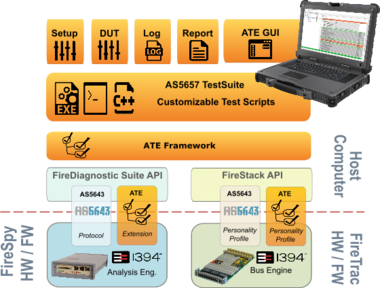The purpose of this tool is to automate and simplify the task of AS5643 compliance verification and testing, which of course is essential for device compatibility within avionics and aerospace programs. The tool utilizes and benefits from proven test and interface components already developed by DapTechnology and adds test executive functionality together with predefined test scripts and a customization and expansion environment.
The AS5657-ATE is useful throughout the entire Life Cycle of a product starting at an early stage of engineering, extending through verification and production and even expands into sustainment of a typical avionics program. Thanks to its expansion capability – the ATE Framework and the test framework can be modified and extended - customization and adaptation to reflect specific project requirements can be implemented easily and with straight forward methods. Usage areas include but are not limited to:
- Requirements Definition
- Software Systems Design Software
- Quality Assurance Verification and Validation of hardware modules
- Product Acceptance
- Systems/Network Integration
- Systems Simulation (includes load testing, HIL, PIL, etc.)
- Module/LRU Qualification Testing (e.g. VMC, Flight Control Actuator, etc.)
- ….
Estimating the cost savings of using the AS5657-ATE over doing the verification testing manually is a relatively complex undertaking since the AS5657 testing specification refers not only to AS5643 but also to IEEE-1394 and its related test specification. This increases the overall amount of work involved and also requires a good understanding of the involved technologies. Taking shortcuts and/or voiding these tests as part of an accompanying process during system engineering can require costly rework and cause delays.

